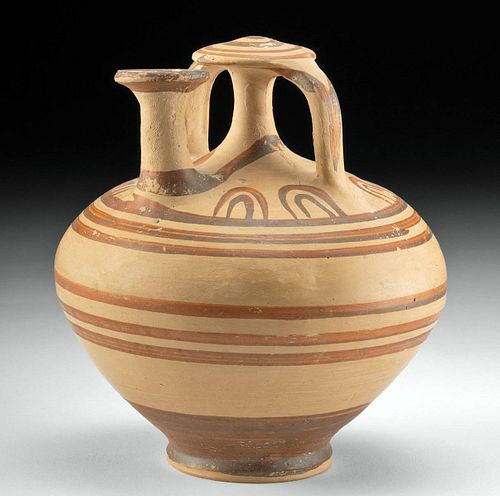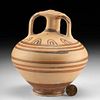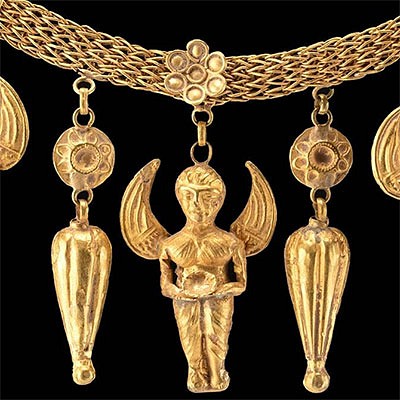Fine Greek Myceneaen Helladic Spouted Vessel
Lot 9
About Seller
Artemis Gallery
686 S Taylor Ave, Ste 106
Louisville, CO 80027
United States
Selling antiquities, ancient and ethnographic art online since 1993, Artemis Gallery specializes in Classical Antiquities (Egyptian, Greek, Roman, Near Eastern), Asian, Pre-Columbian, African / Tribal / Oceanographic art. Our extensive inventory includes pottery, stone, metal, wood, glass and textil...Read more
Categories
Estimate:
$2,250 - $3,500
Absentee vs Live bid
Two ways to bid:
- Leave a max absentee bid and the platform will bid on your behalf up to your maximum bid during the live auction.
- Bid live during the auction and your bids will be submitted real-time to the auctioneer.
Bid Increments
| Price | Bid Increment |
|---|---|
| $0 | $25 |
| $300 | $50 |
| $1,000 | $100 |
| $2,000 | $250 |
| $5,000 | $500 |
| $10,000 | $1,000 |
| $20,000 | $2,500 |
| $50,000 | $5,000 |
| $100,000 | $10,000 |
| $200,000 | $20,000 |
About Auction
By Artemis Gallery
Dec 3, 2020
Set Reminder
2020-12-03 10:00:00
2020-12-03 10:00:00
America/New_York
Bidsquare
Bidsquare : Fine Antiquities, Ethnographic & Fine Art
https://www.bidsquare.com/auctions/artemis-gallery/fine-antiquities-ethnographic-fine-art-6119
Features classical antiquities, ancient and ethnographic art from cultures encompassing the globe. Egyptian, Greek, Roman, Etruscan, Near Eastern, Asian, Pre-Columbian, Native American, African / Tribal, Oceanic, Spanish Colonial, Russian, Fine Art, so much more! All legally acquired, legal to sell. Artemis Gallery info@artemisgallery.com
Features classical antiquities, ancient and ethnographic art from cultures encompassing the globe. Egyptian, Greek, Roman, Etruscan, Near Eastern, Asian, Pre-Columbian, Native American, African / Tribal, Oceanic, Spanish Colonial, Russian, Fine Art, so much more! All legally acquired, legal to sell. Artemis Gallery info@artemisgallery.com
- Lot Description
Ancient Greece, Mycenaean Period, Late Helladic III, ca. 13th century BCE. A hand-built pottery jar of a sizable form with a protruding circular foot, a wide apple-shaped body presenting a rounded shoulder, a pair of arching handles that join at the top of a false central spout, and a functional spout set off-center along the shoulder. Elegant black-slip motifs (though red due to misfiring) are presented atop a cream-slipped ground with concentric bands of varying widths around the body, parabolic arches on the shoulder, a 'bullseye' motif atop the false spout, and additional bands adorning the true spout and handles. A fabulous example from a time when Mycenae was at the peak of its influence in the Mediterranean! Size: 4.9" W x 5.375" H (12.4 cm x 13.7 cm)
This period is so named for the palace at Mycenae, famed in Homeric legend as the opulent seat of King Agamemnon. Excavations at the palace at Mycenae revealed an elite and long-lasting society with a great deal of wealth. This extended to the workshops of artisans who produced pottery like this vessel both for use in Greece and throughout the Mediterranean world; shiploads of similar jars went out as far as the Levant and Spain, carrying oil, wine, and other commodities.
For a stylistically-similar example, please see The Metropolitan Museum of Art, accession number 74.51.1393.
Another stylistically-similar example, of a slightly smaller size, hammered for $9,375 at Christie's, New York "Antiquities" auction (sale 2565, June 8, 2012, lot 55).
Provenance: ex Estate of Eldert Bontekoe, Pegasi Numismatics, Ann Arbor, Michigan USA acquired before 2000
All items legal to buy/sell under U.S. Statute covering cultural patrimony Code 2600, CHAPTER 14, and are guaranteed to be as described or your money back.
A Certificate of Authenticity will accompany all winning bids.
We ship worldwide and handle all shipping in-house for your convenience.
#157890A few petite excisions on exterior surfaces and light fading to dark pigment, otherwise intact and choice. Excellent remains of pigment with craquelure in some areas.Condition
- Shipping Info
-
All shipping is handled in-house for your convenience. Your invoice from Artemis Gallery will include shipping calculation instructions. If in doubt, please inquire BEFORE bidding for estimated shipping costs for individual items.
-
- Buyer's Premium



 EUR
EUR CAD
CAD AUD
AUD GBP
GBP MXN
MXN HKD
HKD CNY
CNY MYR
MYR SEK
SEK SGD
SGD CHF
CHF THB
THB
















